In a competition advertised as “Japan vs. Europe” in Bern, Switzerland, the Japanese men and women were supposed to compete against Europe’s best gymnasts. In the end, the marketing overpromised. Only some of the top European gymnasts competed. Notably absent were the Soviets and East Germans.
Nevertheless, there was some excitement. On the men’s side, Kato Sawao, the 1968 all-around gold medalist, returned to competition after an Achilles tear. On the women’s side, Ilona Békési had a breakout performance, even after the uneven bars collapsed literally on top of her.
Reminder: This naming convention would be quite common at competitions like “The USSR vs. the World.”
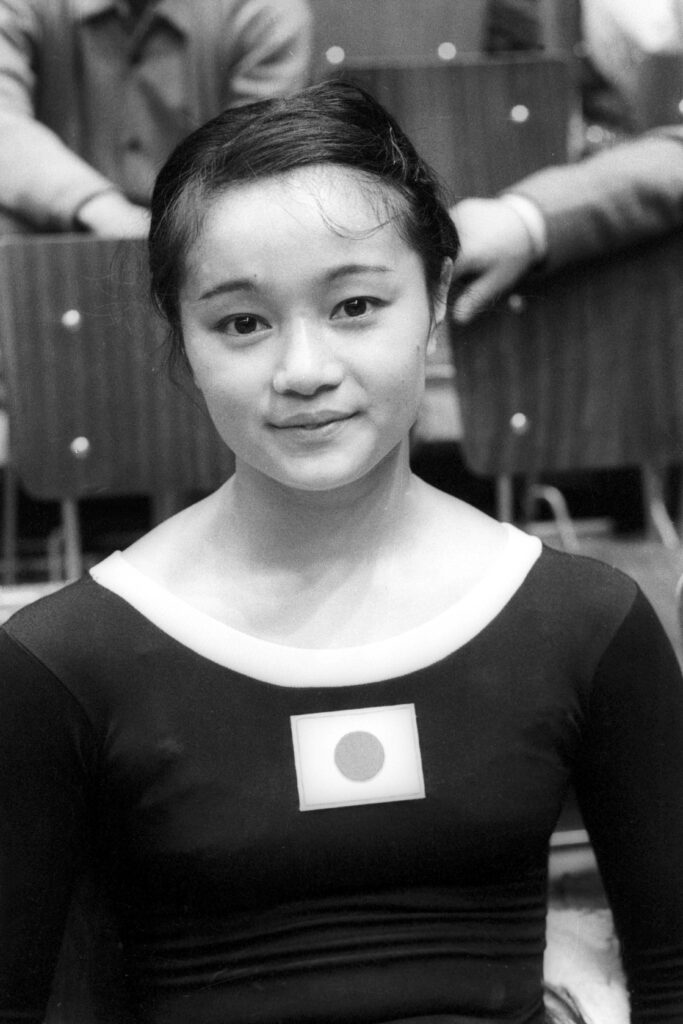
Quick Links: Women’s Results | Men’s Results | Competition Commentary | Women’s Competition | Men’s Competition | Bonus Content: Japan vs. West Germany – Results | Bonus Content: Japanese Gymnasts in Spain
Women’s Results
Team Results
| Team | Comp. | Opt. | Total |
| Europe | 178.65 | 183.90 | 362.55 |
| Japan | 351.35 |
All-Around
| Gymnast | Country | Comp. | Opt. | Total |
| 1. Békési, Ilona | HUN | 36.35 | 37.25 | 73.60 |
| 2. Santer, Ingrid | FRG | 35.75 | 36.60 | 72.35 |
| 3. Olterstorf, Jutta | FRG | 35.65 | 36.65 | 72.30 |
| 4. Fritschi, Käthi | SUI | 35.45 | 36.75 | 72.20 |
| 5. Hirashima Eiko | JPN | 35.95 | 36.10 | 72.05 |
| 6. Kelemen, Márta | HUN | 71.85 | ||
| 7. Komiya Yumiko | JPN | 70.85 | ||
| 8. Miyamoto Toshiko | JPN | 35.65 | 34.95 | 70.60 |
| 9. Alberti, Angela | ITA | 69.10 | ||
| 10. Okada Aiko | JPN | 68.85 | ||
| 11. Bazzi, Patrizia | SUI | 34.05 | 34.10 | 68.15 |
Top Optional Scores on Each Event
| Gymnast | Country | Score |
| Vault | ||
| 1. Hirashima | JPN | 9.30 |
| 2T. Miyamoto | JPN | 9.20 |
| 2T. Békési | HUN | 9.20 |
| 2T. Kelemen | HUN | 9.20 |
| Uneven Bars | ||
| 1. Békési | HUN | 9.40 |
| 2. Fritschi | SUI | 9.25 |
| 3. Alberti | ITA | 9.20 |
| Beam | ||
| 1T. Békési | HUN | 9.25 |
| 1T. Kelemen | HUN | 9.25 |
| 2T. Santer | FRG | 9.20 |
| 2T. Hirashima | JPN | 9.20 |
| Floor | ||
| 1. Békési | HUN | 9.40 |
| 2T. Hirashima | JPN | 9.30 |
| 2T. Fritschi | SUI | 9.30 |
Men’s Results
Team Results
| Team | Comp. | Opt. | Total |
| Japan | 271.00 | 281.35 | 552.35 |
| Europe | 263.35 | 279.00 | 542.35 |
The All-Around
| Gymnast | Country | Comp. | Opt. | Total |
| 1. Kato Sawao | JPN | 55.50 | 57.45 | 112.95 |
| 2. Honma Fumio | JPN | 54.70 | 56.05 | 110.75 |
| 3. Kubica, Mikołaj | POL | 54.15 | 56.15 | 110.30 |
| 4. Mößinger, Walter | FRG | 110.25 | ||
| 5. Morioka Toshiaki | JPN | 53.85 | 56.20 | 110.05 |
| 6. Fujimoto Shun | JPN | 53.50 | 56.20 | 109.70 |
| 7. Hayata Takuji | JPN | 53.45 | 55.45 | 108.90 |
| 8. Rohner, Peter | SUI | 108.70 | ||
| 9. Hürzeler, Roland | SUI | 51.90 | 55.75 | 107.65 |
| 10. Szanja, Andrzej | POL | 49.35 | 55.55 | 104.90 |
| 11. Montesi, Mauricio | ITA | 46.90 | 52.90 | 99.80 |
Top Optional Scores on Each Event
| Gymnast | Country | Score |
| Floor | ||
| 1T. Kato | JPN | 9.50 |
| 1T. Honma | JPN | 9.50 |
| 3. Morioka | JPN | 9.45 |
| Pommel Horse | ||
| 1. Kato | JPN | 9.65 |
| 2. Kubica | POL | 9.50 |
| 3. Hürzeler | SUI | 9.40 |
| Rings | ||
| 1. Kato | JPN | 9.65 |
| 2T. Honma | JPN | 9.50 |
| 2T. Morioka | JPN | 9.50 |
| Vault | ||
| 1. Morioka | JPN | 9.55 |
| 2. Szanja | POL | 9.45 |
| 3T. Kato | JPN | 9.40 |
| 3T. Fujimoto | JPN | 9.40 |
| Parallel Bars | ||
| 1. Honma | JPN | 9.55 |
| 2T. Kubica | POL | 9.50 |
| 2T. Kato | JPN | 9.50 |
| High Bar | ||
| 1. Kato | JPN | 9.75 |
| 2. Honma | JPN | 9.70 |
| 3. Morioka | JPN | 9.65 |
Competition Commentary
This competition was a way to commemorate the 90th anniversary of the FIG.
The International Gymnastics Federation is ninety years old. The Japanese used this anniversary to visit Europe and assess where they and their opponents stand in their preparation by competing in the host country of next year’s Olympics, as well as neighboring Switzerland, in these two strongholds of world gymnastics.
Népsport, Oct. 3, 1971
Kilencven éves a Nemzetközi Torna Szövetség. Ezt az évfordulót használták fel a japánok, hogy ellátogassanak Európába és a jövő évi olimpia rendező országában, valamint a szomszédos Svájcban, a világ tornasportjának e két fellegvárában megmérkőzve felmérjék, hol is állnak a felkészülésiben ők maguk és ellenfeleik.
On the Marketing
There was criticism of the event’s marketing, given that it was perhaps the “Europe B” team or a “European selection.”
With all due respect, the flyer “Europe against Japan” was really a bit exaggerated. With two representatives each from the USSR, GDR and CSSR among the girls and perhaps two men each from the USSR, GDR, and Poland, this designation would have been fine. As could be heard, the FIG (International Gymnastics Federation) had initially made efforts in this direction — unfortunately there were cancellations. What was set up or invited was perhaps “Europe B” or a “Europe selection.” That says nothing against the good class of the two European squads — the chosen ones are certainly among the best in the world and can be ranked right behind the best in the world — so definitely still above the international average.
Bieler Tagblatt, Sept. 24, 1971
Mit Verlaub zu sagen: Die Affiche «Europa gegen Japan» war nun wirklich etwas übertrieben. Mit je zwei Vertreterinnen aus der UdSSR, DDR und der CSSR bei den Mädchen und vielleicht je zwei Männern aus der UdSSR, DDR und Polen wäre diese Bezeichnung in Ordnung gewesen. Wie zu hören war, hatte sich der ITB (Internationaler Turner-Bund) zuerst auch in dieser Richtung bemüht — leider kamen Absagen. Was nun aufgestellt bzw. Eingeläden wurde, war vielleicht «Europa B» oder eine «Europa-Auswahl». Damit sei nichts gegen die gute Klasse der beiden europäischen Riegen gesagt — die Auserkorenen gehören sicher zur internationalen Spitze und sind unmittelbar hinter den Weltbesten einzustufen — sicher also noch immer über dem internationalen Durchschnitt.
In the lead-up to the event, newspapers tried to gin up interest and suspense by pointing out that the Japanese were bringing only five gymnasts. With five counting scores per apparatus, they had no margin for error.
Is Japan strong enough to beat a European team made up of top gymnasts from different countries? The Russians are missing here as the big opponents of the Japanese. This failure is less significant than the fact that the Japanese are only five men and therefore are forfeiting a score on each event, while the worst result on each event is not counted on the European team.
Die Tat, Sept. 21, 1971
Ist Japan stark genug, um eine aus besten Turnern aus verschiedenen Ländern zusammengestellte Europariege schlagen zu können? Zwar fehlen hier die Russen als grosse Gegenspieler der Japaner. Dieser Ausfall ist aller weniger ausschlaggebend als die Tatsache, dass die Japaner nur mit fünf Mann antreten und daher auf ein Streichresultut verzichten, während in der Europariege des schlechteste Ergebnis in jeder Disziplin wegfällt.
Money was reportedly the reason that Japan sent only five competitors.
According to the official explanation, there was no money for the trip of the sixth competitor…
Népsport, Oct. 3, 1971
Akiket az Európa-válogatott két tagja, a lengyel M. Kubica és a nyugatnémet Messinger megelőzött…
The Women’s Competition
On the women’s side, one of the European gymnasts had to join the Japanese team, who had only four gymnasts.
The organizers had to improvise valiantly so that a showdown could take place at all: Angela Alberti from Italy was sent to the guest team because the Japanese had brought only five gymnasts with them. This certainly deserves criticism when a competition of this magnitude is staged, since it requires that the teams compete with a full cast.
Neue Zürcher Nachrichten, Sept. 23, 1971
Damit überhaupt ein Kräftemessen zustande kam, mussten die Organisatoren wacker improvisieren: Angela Alberti aus Italien wurde ins Gästeteam beordert, da die Japaner nur fünf Turnerinnen mitgebracht hatten. Dies bedarf sicher einer Kritik, wenn ein Wettkampf von solchem Ausmass aufgezogen wird, bedingt das doch, dass die Mannschaften in Vollbesetzung antreten.
Prior to this event, the Japanese team had performed in a competition in West Germany, where Matsuhisa was injured. That’s why there were only four Japanese gymnasts.
Matsuhisa Miyuki suffered an elbow injury in Stuttgart, which condemned her to spectating.
Die Tat, Sept. 23, 1971
Miyuki Matsuhisa eine Ellbogenverletzung zugezogen hatte, die sie zum Zuschauen verurteilte.
There was poor attendance for the women’s competition.
The continental meeting of apparatus gymnasts from Japan and Europe in the Bern ice rink did not have the desired attraction. Only around 2,000 spectators attended the event, which, contrary to expectations, was clearly dominated by the Europeans.
Neue Zürcher Nachrichten, Sept. 23, 1971
Nicht die gewünschte Anziehungskraft hatte das Kontinentaltreffen der Geräteturnerinnen aus Japan und Europa in der Berner Eishalle. Nur gegen 2000 Zuschauer wohnten dem Geschehen bei, das wider Erwarten von den Europäerinnen klar dominiert wurde.
The newspapers partially blamed the TV broadcast for the poor attendance.
On Tuesday afternoon it was primarily Bern’s school youth who, with free admission, populated the stadium to some extent, while in the evening — with sometimes “nutritious” prices — a knowledgeable and friendly audience appeared; of course, the TV partial direct transmission strongly influenced the (bad) attendance.
Der Bund, Sept. 22, 1971
Am Dienstagnachmittag war es in erster Linie Berns Schuljugend die – bei freiem Eintritt – das Stadion einigermassen bevölkerte während am Abend – bei teilweise «nahrhaften» Preisen – ein ebenso sachkundiges wie freundliches Publikum erschien; natürlich beeinflusste die TV-Teildirektübertragung den (schlechten) Aufmarsch stark.
Note: Women’s competitive gymnastics was relatively new in Switzerland at the time.
Hungarian gymnasts Békési and Kelemen were the standouts.
The trainer from Czechoslovakia, who works in Italy, Jaroslava Matlochová, skilfully led the European team, which had two Hungarian gymnasts with certain competition experience, Ilona Békési and Marta Kelemen.
Neue Zürcher Nachrichten, Sept. 23, 1971
Die in Italien tätige Trainerin aus der CSSR, Jaroslava Matlocha, führte die Europaauswahl, die in den Ungarinnen, Ilona Bekesi und Marta Kelemen zwei Turnerinnen mit gewissen Wettkampferfahrungen hatte, gekonnt durch den Wettkampf.
And team Europe dominated the competition.
While the team success of the Europeans was never in question (the Japanese only totaled more points on compulsory floor), there was an exciting struggle for individual victory. Békési was primarily challenged by Hirashima. But the two Germans and Käthi Fritschi also stormed after the top place with brisk performances. Finally, the woman from Lucerne took an honorable second place in the optionals. However, she was unable to make up for the deficit from compulsories.
Neue Zürcher Nachrichten, Sept. 23, 1971
Während der Mannschaftserfolg der Europäerinnen nie in Frage stand (nur in der Bodenpflicht totalisierten die Japanerinnen mehr Punkte), so zeichnete sich um den Einzelsieg ein begeisterndes Ringen ab. Bekesi sah sich in erster Linie von Hirashima gefordert. Aber auch die beiden Deutschen und Käthi Fritschi stürmten mit flotten Leistungen der Spitze nach. Schliesslich belegte die Luzernerin in der Kür den ehrenvollen zweiten Rang. Den Rückstand aus der Pflicht vermochte sie allerdings nicht zu egalisieren.
The uneven bars collapsed during Békési’s bar routine.
Despite additional tests, Békési proved to be a reliable competitor. On the uneven bars, where Hirashima fell out of the running, a cable broke after the Hungarian’s powerful mount, and the equipment collapsed together with the athlete. Fortunately, the gymnast was not injured, but her nerves were put to the test. During her second routine, Békési didn’t show any nerves, and, with a 9.40, she booked the highest score of the day!
Neue Zürcher Nachrichten, Sept. 23, 1971
Trotz zusätzlichen Prüfungen, bestätigte sich Bekesi als zuverlässige Wettkämpferin. Am Stufenbarren, wo übrigens Hirashima durch einen Sturz aus der Entscheidung fiel, riss nach dem turbulenten Eingang der Ungarin ein Seil und das Gerät stürzte samt der Athletin in sich zusammen. Glücklicherweise nahm die Turnerin keinen Schaden, aber ihre Nerven wurden auf eine harte Probe gestellt. In der Wiederholung liess sich Bekesi nichts anmerken und mit 9.40 buchte sie die Tageshöchstnote!
It happened during her front salto to the high bar, and the bars actually collapsed on her. Her 9.40 on bars was the highest score of the day.
The exercise with the highest score of the whole competition – the performance of the Hungarian Békési on the uneven bars – was preceded by a breakdown of the apparatus when the gymnast risked a massive somersault from the lower bar to the upper bar; she literally was under the apparatus but stayed unharmed and repeated the exercise to the wildly acclaimed 9.40.
Der Bund, Sept. 22, 1971, bold type my own.
Der Uebung mit der höchsten Note des ganzen Wettkampfes – die Darbietung der Ungarin Bekesi am Stufenbarren – ging ein Zusammenbruch des Gerätes voraus als die Turnerin einen wuchtigen Salto vom untern auf den oberen Holm riskierte; sie geriet buchstäblich unter das Gerät blieb aber heil und wiederholte die Uebung zur stürmisch bejubelten 9.40.
You can see Békési’s mount in this video from the 1971 European Championships:
There was some suspense given that both Okada (JPN) and Bazzi (SUI) fell twice on beam.
Of course, the fact that Japan’s team did not have a discarded result had a negative effect here, particularly when Okada fell twice from the balance beam (7.90). However, the same mishap happened to the little Tessinerin Patrizia Bazzi, who also lost half a point each time after falling off the beam.
Die Tat, Sept. 23, 1971
Natürlich wirkte sich aueh hier nachteilig aus, dass Japans Riege kein Streichresultat hatte, krass beim zweimaligen Zubodengehen von Okada am Schwebebalken (7.90). Das gleiche Missgeschick passierte allerdings auch der kleinen Tessinerin Patricia Bazzi, die ebenfalls zweimal durch Sturz vom Balken je einen halben Punkt verlor.
That said, one commentator thought that beam was rather boring.
Once again, gymnastics on the balance beam was a boring dance that was interspersed with cramped balance exercises and differed greatly from the lively uneven bars and the subsequent floor exercises.
Der Bund, Sept. 22, 1971
Einmal mehr bildete das Turnen auf dem Schwebebalken ein langweiliges Tänzeln das mit verkrampften Balanceübungen durchsetzt war und vom beschwingten Barren- und dem nachfolgenden Bodenturnen stark abstach.
Other tidbits: Kelemen performed a handspring full twist on vault.
The vault that could have been the best, Kelemen’s handspring with a full twist, ended with the Hungarian landing on her knees.
Der Bund, Sept. 22, 1971
Der Sprung der die Bestleistung hätte werden können der Ueberschlag mit ganzer Drehung von Kelemen misslang indem die Ungarin auf den Knien landete.
Reminder: This type of vault was rare. Most top gymnasts performed a Yamashita, which was out a 10.0 and easier to land.
All in all, the judging was accurate.
The scores were of international rigor and that was a good thing. 9.2 to 9.3 were (rather rare) top scores.
Bieler Tagblatt, Sept. 24, 1971
Die Wertungen waren von internationaler Strenge und das war gut so. 9,2 bis 9,3 waren (eher seltene) Spitzennoten.
Had Japan had a full team, they might have scored more points.
Since the sympathetic Asian women unfortunately did not have a “substitute” with them, the Italian Angela Alberti stepped in for Nippon’s champion. It is safe to assume that the Far East crowd would have improved their points total by about 6 to 7 points with their favorite — but the victory for “Europe” could not have been prevented.
Bieler Tagblatt, Sept. 24, 1971
Da die sympathischen Asiatinnen leider keine «Ersatzmännin» bei sich hatten, sprang die Italienerin Angela Alberti für Nippons Meisterin ein. Man kann annehmen, dass die Schar aus dem Fernen Osten ihr Punktetotal mit ihrer Favoritin um etwa 6 bis 7 Punkte verbessert hätte — aber der Sieg für «Europa» wäre trotzdem nicht zu verhindern gewesen.
That said, the general impression was that the Japanese women were not at the level they used to be at.
In recent years, [the Japanese women’s artistic gymnasts] have been considered the fourth best nation in women’s artistic gymnastics and even pushed the Czechs under pressure in Ljubljana a year ago. At the moment they seem to have fallen behind rather slightly.
Bieler Tagblatt, Sept. 24, 1971
Sie galten in den letzten Jahren als die viertbeste Nation im Damenkunstturnen und haben vor einem Jahr in Laibach sogar die Tschechinnen bedrängt. Im Moment scheinen sie eher leicht zurückgefallen zu sein.
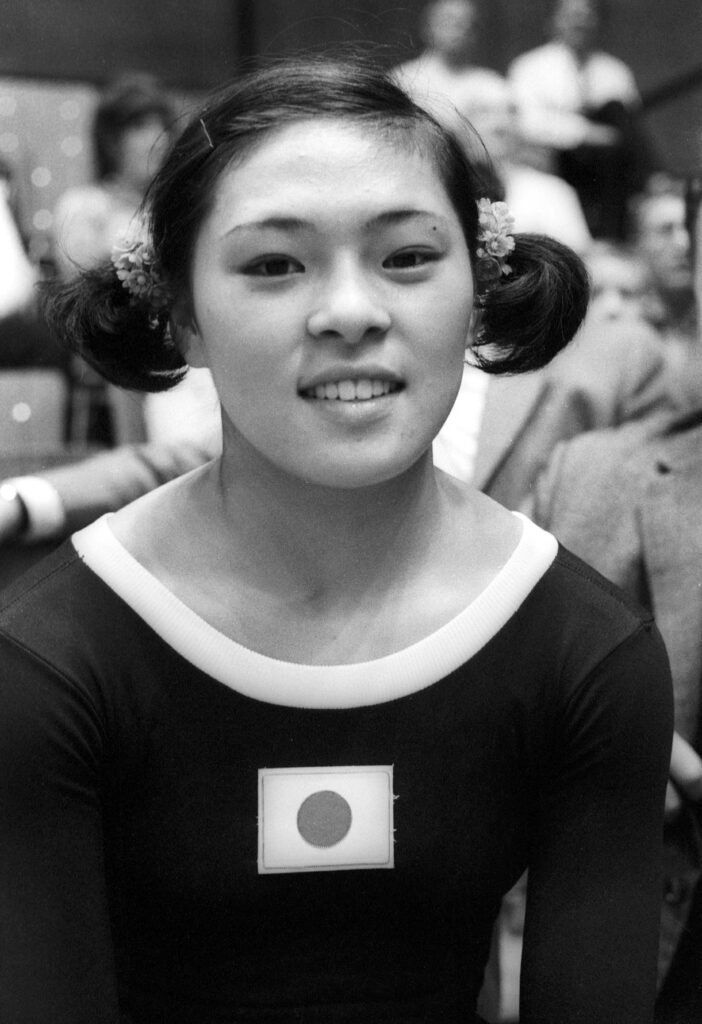
The Men’s Competition
The men used the compulsory routines for the 1972 Olympics, and there was some debate over the dismount on parallel bars.
Even the technicians in the International Gymnastics Federation will hardly be able to avoid clearing up certain ambiguities in the interpretation. We are primarily thinking of the parallel bars dismount, where the circle flank is required at the end. According to European terms, a circle flank is correctly executed when both legs circle over both bars. The Asians obviously had a different opinion, they were extremely elegant; and peppy; into a handstand and then, in turn, turned and floated toward the ground.
Karl-Heinz Tschocke from the technical committee at the FIG confirmed our observations and believes that the body should only be allowed to rise up to 30 degrees in the upright position.
This example makes it clear that even the Japanese came to Europe to learn.
Neue Zürcher Nachrichten, Sept. 24, 1971
Selbst die Techniker im internationalen Turnerbund werden kaum darum herum kommen, gewisse Unklarheiten in der Interpretation zu beheben. Wir denken in erster Linie an den Barrenausgang, wo zum Abschluss die Kreisflanke verlangt wird. Nach europäischen Begriffen ist eine Kreisflanke richtig ausgeführt, wenn mit beiden Beinen über beide Holmen gekreist wird. Anderer Meinung waren offenbar die Asiaten, die äusserst elegant; und schwungvoll; in den Handstand stiegen und in der Folge, abdrehten und dem Boden zu schwebten.
Karlheinz Tschocke vom technischen Komitee im ITB bestätigte unsere Beobachtungen und ist der Ansicht, dass der Körper lediglich bis zu 30 Grad in die Hochhalte steigen darf.
Dieses Beispiel führt klar vor Augen, dass selbst die Japaner nach Europa kamen, um zu lernen.
In other words, the Japanese gymnasts performed a handstand and then turned, which was originally drawn in Modern Gymnast, December 1970:
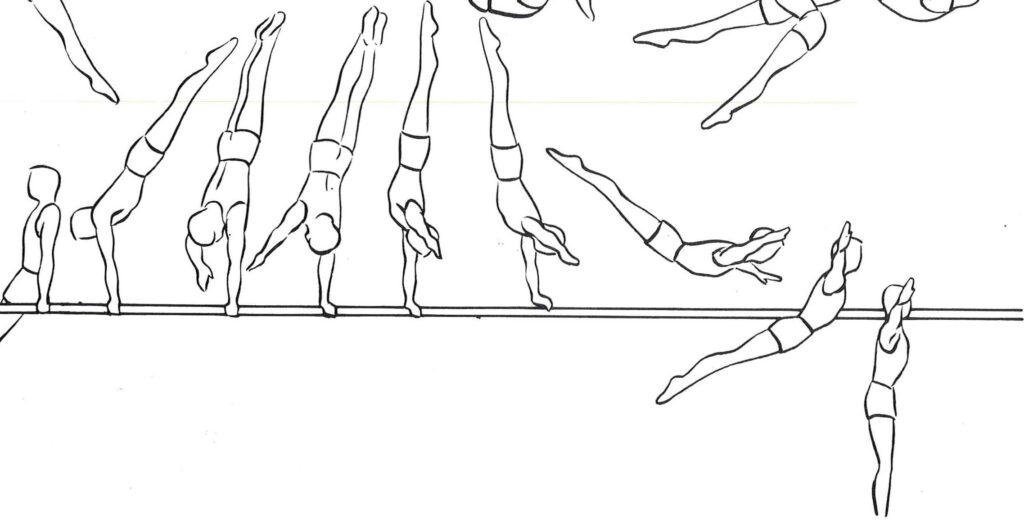
But they were supposed to do a flank circle, like this:
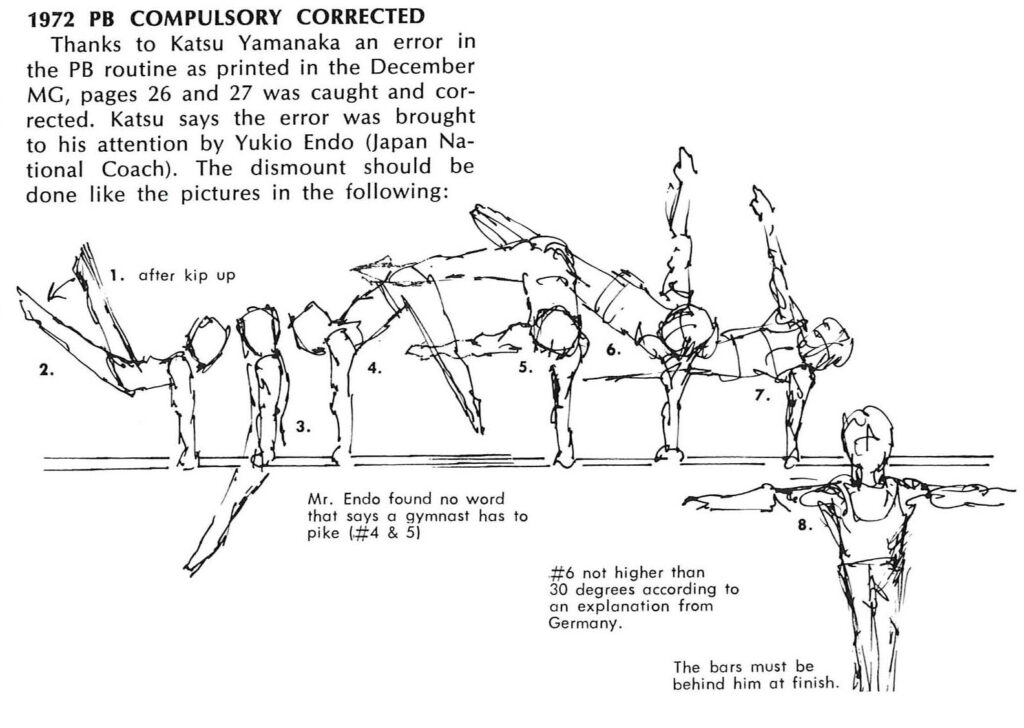
The Japanese men did make some errors.
Certain inventions and variations in the exercises often made their European colleagues shake their heads in disbelief. But somehow it was comforting to see that Japanese can also fall, they were not immune to mistakes and weaknesses. After all, men are not machines, and these moments, which cannot be taken into account in advance, are ultimately what make sport so appealing.
Bieler Tagblatt, Sept. 24, 1971
Gewisse Einfälle und Variationen in den Uebungen liessen oft ihre europäischen Kollegen ungläubig den Kopf schütteln. Aber irgendwie war es doch auch wieder tröstlich zu sehen, dass auch Japaner fällieren können, auch sie waren gegen Patzer und Schwächen nicht gefeit. Der Mensch ist eben doch keine Maschine und diese zum voraus nicht einzukalkulierenden: Momente machen nicht zuletzt den Reiz des Sportes aus.
The spectators might have been bored because there was no moment of suspense during the competition. It was obvious that the Japanese were going to win.
What remains for the gymnastics nations, which can hardly operate with the same possibilities, is the attentive observation in a competition.
In this respect, the Berne meeting was a great success, even if it was perhaps less attractive for the spectators, because there was no moment of tension.
Neue Zürcher Nachrichten, Sept. 24, 1971
Was den Turnernationen, die kaum mit gleichen Möglichkeiten operieren können, übrig bleibt, ist die aufmerksame Beobachtung in einem Wettkampf.
In dieser Richtung war das Bernertreffen ein grosser Erfolg, wenn auch für den Zuschauer vielleicht weniger attraktiv, denn das Spannungsmoment blieb aus.
Kato Sawao made a tremendous comeback from his Achilles injury.
Mexico’s Olympic champion Sawao Kato made a sparkling comeback after being sidelined last year with an Achilles tendon injury. He again performed the standard formation of the Japanese. His invetions in the optional program are unrivaled, and his mastery of the compulsory program is undisputed. He received the highest score on practically all apparatus.
Neue Zürcher Nachrichten, Sept. 24, 1971
Ein glänzendes Comeback feierte der Olympiasieger von Mexiko, Sawao Kato, nachdem er letztes Jahr einer Achillessehnenverletzung wegen pausieren musste. Er turnte sich wiederum in die Standardformation der Japaner. Seine Einfälle im Kürprogramm sind unerreicht und die Beherrschung des Pflichtprogramms unbestritten. Praktisch an allen Geräten zeichnete er für die höchste Wertung.
The Hungarian press said that Kato was almost at the level of his 1968 performance.
Kato Sawao gave a good average performance, especially in Bern, he competed in an almost Mexican style [i.e. like he competed in 1968], receiving scores between 9.40 and 9.75 for his optional exercises.
Nepsport, Oct. 3, 1971
Szavao Kató azonban, különösen Bernben jó átlagteljesítményt nyújtott, szinte mexikói formában versenyzett, szabadom választott gyakorlataira 9.40 és 9.75 között kapott pontokat.
Japan brought its “B team,” which was still a cut above the rest.
You have to keep this in mind: the Japanese didn’t even have their very strongest team. It is assumed that only Olympic champion Kato and last year’s World Championship sixth-placed Honma will be in Munich. The old veteran Hayata will hardly be there anymore and Morioka and Fujimoto are regarded as young hopes for 1976… What a reservoir these Japanese must have at home. The “bottom half” of the Japanese squad would be welcomed on their squads even by the best European teams!
Bieler Tagblatt, Sept. 24, 1971
Man muss sich das vor Augen halten: Die Japaner hatten nicht einmal ihre allerstärkste Formation zur Stelle. Man nimmt an, dass nur der Olympiasieger Kato und der letztjährige WM-Sechste Honma in München sein werden. Der alte Routinier Hayata wird kaum mehr dabei sein und Morioka und Fujimoto gelten als Nachwuchshoffnungen für 1976… Was für ein Reservoir müssen diese Japaner zuhause haben. Die «untere Hälfte» der japanischen Riege würde selbst von den besten europäischen Teams mit Kusshand in ihre Mannschaften aufgenommen!
Note: Kato was the only Japanese men’s artistic gymnast from this competition to make the 1972 team. Both Kato and Honma were on the team for the 1974 World Championships, and Kato and Fujimoto competed at the 1976 Olympics.
That said, gymnastics pundits didn’t know what to make of the performances.
The results of the two clashes [in Stuttgart against West Germany and in Bern against Europe] give a rather mixed picture. In Stuttgart, the Japanese machine certainly had problems, the compulsory exercises were quite poor, and the small victory achieved in the team competition, by only 7.40 points, also showed that the rejuvenated West German team made significant progress. (A year ago, at the World Cup in Ljubljana, the difference between the two teams was still 40 points.) A few days later, against an occasional European team in Bern, the boys of the “country of the rising sun” fared much better and, although not against the strongest opponent (since the Soviet and GDR gymnasts were not present), they won with improved performance and confidence.
Nepsport, Oct. 3, 1971
A két összecsapás eredménye meglehetősen felemás képet ad. Stuttgartban bizony akadozott a japán gépezet, a kötelező gyakorlatok elég gyengén sikerültek, s a csapatversenyben elért csekély, mindössze 7.40 pontos győzelem egyúttal azt mutatta, hogy a megfiatalított nyugatnémet együttes jelentősen előrelépett. (Egy éve, a ljubljanai világbajnokságon még 40 pont volt a különbség a két csapat között.) Néhány nappal később, Bernben egy alkalmi Európa-válogatott ellen már sokkal jobban ment a „felkelő nap országa” fiainak és ha nem is a legerősebb ellenféllel szemben (hiszen nem voltak jelen a szovjet és az NDK-beli tornászok), de javuló teljesítménnyel, magabiztos módon vívták ki a győzelmet.
The confusion is evidenced by the number of “however” statements in the following sentences:
However, the meeting in Bern, during which the video recorders (one of them in the hands of Boris Shakhlin) showed that Stuttgart was at most a small derailment, a weaker day. However, due to the absence of the strongest opponents, it is difficult to give a true picture of the current balance of power. However, one thing can still be predicted: a sharp Japanese-Soviet duel will set the tone for the gymnastics competitions in Munich.
Nepsport, Oct. 3, 1971
A berni találkozó azonban, amelyen sűrűn berregtek a filmfelvevőgépek (az egyik éppen Borisz Sahlin kezében), azt mutatta, hogy Stuttgart legfeljebb apró kisiklás, egy gyengébb nap volt. A legerősebb ellenfelek távolléte miatt azonban nehéz valós képet adni a jelenlegi erőviszonyokról. Egy azonban így is megjósolható: éles japán —szovjet párharc adja majd meg a müncheni tornászversenyek alaphangját.
My thought bubble: It’s a shame that the video footage hasn’t been preserved and archived online.
Bonus Content: Results from Japan vs. West Germany
On September 17 and 18, 1971, the Japanese gymnasts competed against the West German gymnasts. Here were the results.
Men’s Team
- Japan – 542.60
- West Germany – 535.20
Men’s All-Around
- Kato Sawao, JPN, 111.55
- Honma Fumio, JPN, 109.20
- Walter Mößinger, FRG, 108.80
- Morioka Takeshi, JPN, 107.65
- Fujimoto Shun, JPN, 107.45
- Günter Spies, FRG, 107.00
- Hayata Takuji, JPN, 106.75
- Bernd Effing, FRG, 105.45
- Erich Heß, FRG, 105.40
- Eberhard Gienger, FRG, 104.15
- Toni Unden, FRG, 57.85
Women’s Team
- West Germany – 329.20
- Japan – 327.65
Women’s All-Around
1. Jutta Oltersdorf, FRG, 72.55
2. Uta Schorn, FRG, 72.15
3. Hirashima Eiko, JPN, 71.80
4. Okada Aiko, JPN, 71.05
5T. Angelika Kern, FRG, 70.65
5T. Komiya Yumiko, JPN, 70.65
7. Ingrid Santer, FRG, 70.25
8. Miyamoto Toshiko, JPN, 69.15
9. Angela Drutschmann, FRG, 68.75
10. Marlies Lehmann, FRG, 68.50
11. Matsuhisa Miyuki, JPN, 45.00
Source: Jahrbuch der Turnkunst, 1972
Bonus Content: Japanese Gymnasts in Spain in 1971
Of note, a Japanese gymnast (possibly Okada Aiko) performed a back-handspring swing-down on beam. You can see it at the 16:27 mark in the video above.
In other words, Korbut was not the first gymnast to perform the skill, but there was a difference in how Korbut performed the skill. She added more height to the element.
Note: An unidentified gymnast performed a back-handspring swing-down at the 1968 Olympics, as well.
Misattribution of eponymous skills happens from time to time. For example, in his autobiography, Kato Sawao indicates that he wasn’t the first to perform the Kato on parallel bars.
Speaking of myself, there is one other thing: I have a “Kato” on the parallel bars, but this was not achieved by appealing for myself. I had no idea when it got that name. It is a technique with a long name, “Bent-arm forward swing hop with turn to support,” but it is a revival of a technique that had been around for some time.
The Path of Beautiful Gymnastics: The Story of Sawao Kato
私はといえば、たつた一つ、平行棒に「カトウ」があるが、これは自らアピールして実現したものではない。いつの間にか、そぅ名付けられていた。「屈腕前振り跳び上向き転向支持」といぅ長い名前の技なのだが、これは前からあつた技を私が復活させたものである。
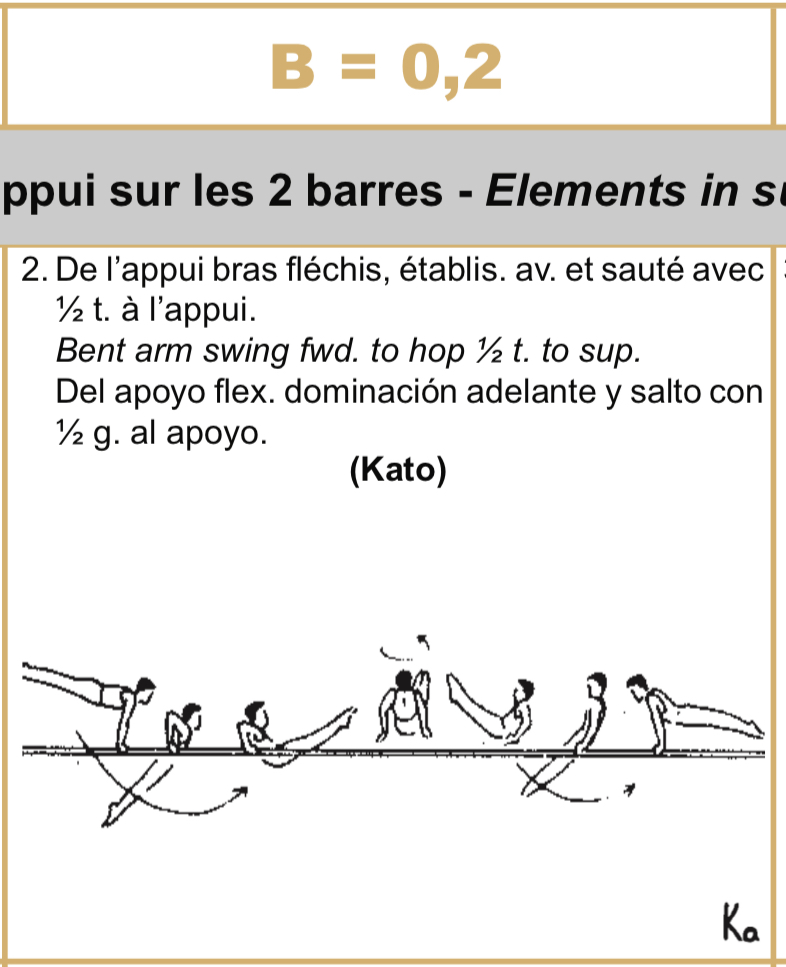
More on 1971